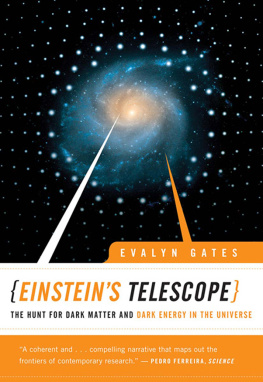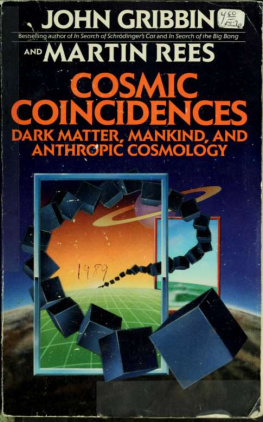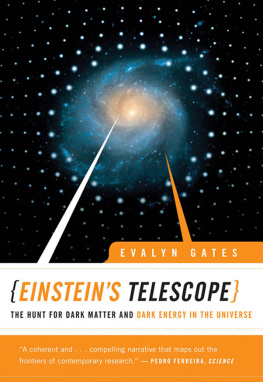Contents
Pagebreaks of the print version

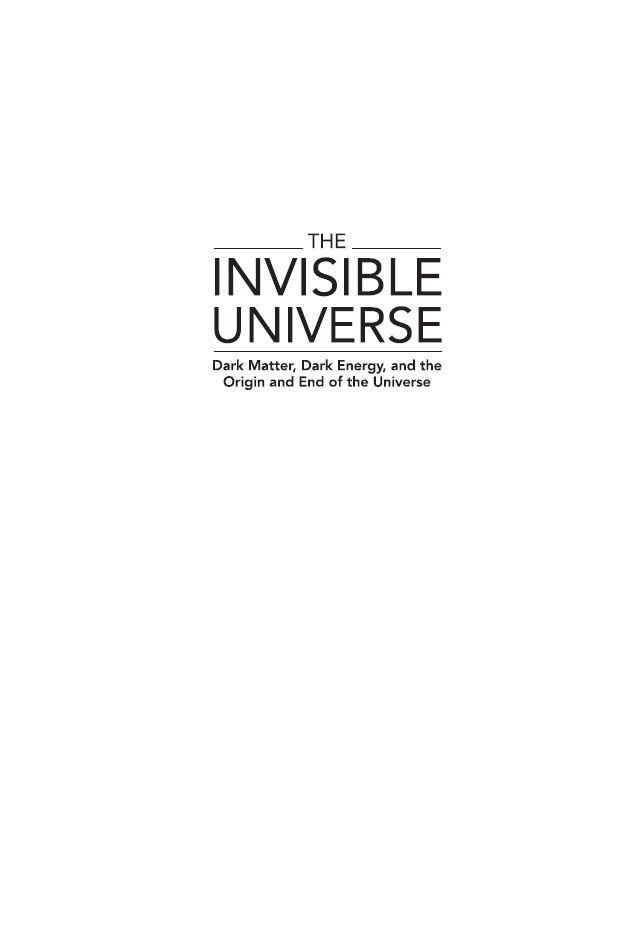
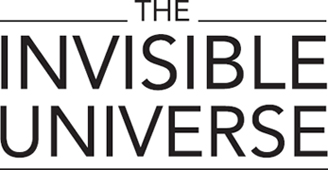
Dark Matter, Dark Energy, and the
Origin and End of the Universe
Antonino Del Popolo
Universit degli Studi di Catania, Italy

Published by
World Scientific Publishing Co. Pte. Ltd.
5 Toh Tuck Link, Singapore 596224
USA office: 27 Warren Street, Suite 401-402, Hackensack, NJ 07601
UK office: 57 Shelton Street, Covent Garden, London WC2H 9HE
British Library Cataloguing-in-Publication Data
A catalogue record for this book is available from the British Library.
THE INVISIBLE UNIVERSE
Dark Matter, Dark Energy, and the Origin and End of the Universe
Copyright 2021 by World Scientific Publishing Co. Pte. Ltd.
All rights reserved. This book, or parts thereof, may not be reproduced in any form or by any means, electronic or mechanical, including photocopying, recording or any information storage and retrieval system now known or to be invented, without written permission from the publisher.
For photocopying of material in this volume, please pay a copying fee through the Copyright Clearance Center, Inc., 222 Rosewood Drive, Danvers, MA 01923, USA. In this case permission to photocopy is not required from the publisher.
ISBN 978-981-122-943-5 (hardcover)
ISBN 978-981-122-944-2 (ebook for institutions)
ISBN 978-981-122-945-9 (ebook for individuals)
For any available supplementary material, please visit
https://www.worldscientific.com/worldscibooks/10.1142/12074#t=suppl
Desk Editor: Rhaimie Wahap
Typeset by Stallion Press
Email:
Printed in Singapore
CONTENTS
INTRODUCTION
Everyone is a moon, and has a dark
side which he never shows to anybody.
Mark Twain
Humans are an inseparable part of the universe, material that emerged from the Big Bang, whose bowels, muscles, lungs, and heart are associated with the elements forged in the nuclei of the stars. It is therefore no coincidence that the sky has intrigued man from prehistory, like the cave paintings, representing gods and heroes, as well as temples and ancient astronomical observatories testify. This is a peculiarity of our species, classified by Linnaeus as Homo sapiens. The Greeks instead indicated the human being with the term anthropos, which in an etymological interpretation would mean the one who looks up.
Of all the species that lived and live on this planet, as far as we know, man is the only being capable of consciousness, of observing the sky with awareness, understanding its beauty, and asking questions on the meaning of life and on that of death, on the origin and on the end, both personal and that of the universe. Moreover, the term homo (man) has the same root as the term humus, earth, mud. So the Homo anthropos is a sort of bridge between earth and sky, endowed with an innate curiosity that leads him to try to study and understand the mysteries of nature. The immense number of human beings who have lived to date on Earth are united by heaven. Languages and civilizations have changed or disappeared, together with the religions that have addressed the way of seeing life and its purposes. Todays social organization is certainly very different from that of some tens of thousands of years ago. Evolution in all areas of life has changed and eliminated what were firm points in the way of thinking. In all these changes, a constant is the immutability of the sky, which has remained the same, except for minor changes. The Moon always has the same phases, and the Sun follows its annual cycle linked to the seasonal changes. The position of the constellations, visible in different periods of the year, is still almost unchanged. Ultimately, human beings from 30,000 years ago lived under our own sky, saw the same constellations, and the same stars in similar positions.
Obviously, although the sky is the same, it is perceived differently: different is the understanding of the objects and phenomena of which it is constituted, together with their meaning. For the Australian Aborigines, the Sun was a woman who woke up in her camp in the east and lighted a fire, then lighted a torch that she carried around the sky. Before starting the journey, she decorated herself with red ocher, which, dispersing in the air, dyed the cloud with red. That was the dawn. Once she reached the west, she changed her makeup, dying the clouds with yellow and red, and that was the sunset. Finally, the Sun-Woman made an underground journey to return to her camp. For the Indo-European peoples, the Sun and the Moon moved in the sky on horse-drawn carriages, guided by a charioteer. The Vikings explained the eclipses of the Sun by referring to a wolf, Skoll, who ran after the Sun god, Sol, and, once captured, tore him apart. When this happened, people made a great noise with pots and pans to frighten the wolf to make the Sun return. The same thing happened during the lunar eclipse: the wolf Hati devoured the Moon (Mani). The Persians believed that eclipses were divine punishments, and for the Romans it was unthinkable that eclipses were due to natural causes. The understanding of the phenomenon and the prediction of eclipses is attributed to the Greeks (Thales 585 BC), although it seems that the ancient Chaldeans, 2500 years ago, already knew the 18-year cycle called the Saros cycle, at the end of which eclipses repeat.

Skoll and Hati (2009). Credit: Akreon. Painting.
Ignorance of natural events led men to create myths and invent gods who supervised every aspect of life. Although several Greek and Magna Graecia philosophers (present-day Sicily) like Pythagoras, Archimedes, Anaximander, Empedocles, and Aristarchus, started to have a more scientific view of the world, it was often not accepted for cultural or political reasons. Epicurus did not accept atomism. Even Kepler, many centuries later, believed that planets were sentient beings. Descartes and Newton, although they believed that natural laws had been established by God and that the universe regulates itself by following these laws, believed that God could change them at any time. For Newton, God continually intervened to make the planets follow the right orbits. With the evolution of research and scientific thought, the epexegetic role of divinities and myths has been increasingly reduced. The roles of religion and science have clearly separated.
As we said, the sky unites us and our ancestors. Until a century ago, the universe was considered to be constituted just by stars, planets, and comets.
Today, the universe is much more complex for us than for our ancestors: black holes, neutron stars, white dwarfs, supernovae, various types of nebulae, galaxies, clusters, superclusters of galaxies, and much more. The most shocking fact is that today we know that all the innumerable objects we observe in our universe represent only about 5% of the matter that constitutes it, the visible one. Our advantage in knowledge compared to our ancestors sees a significant reduction if we think that we have a limited knowledge even of the small part of the universe we see. We also dont even know what its actually made of. We can only quantify our degree of ignorance about the universe with a percentage, 95%, and this ignorance has a name: dark matter and dark energy. Of the first we have some ideas: these are probably elusive particles that weakly interact with matter. Of the second, which started to manifest itself just a few billion years ago, we know even less; it is possible that it is energy of the vacuum that acts as repulsive gravity, but in fact we are groping in the dark.



